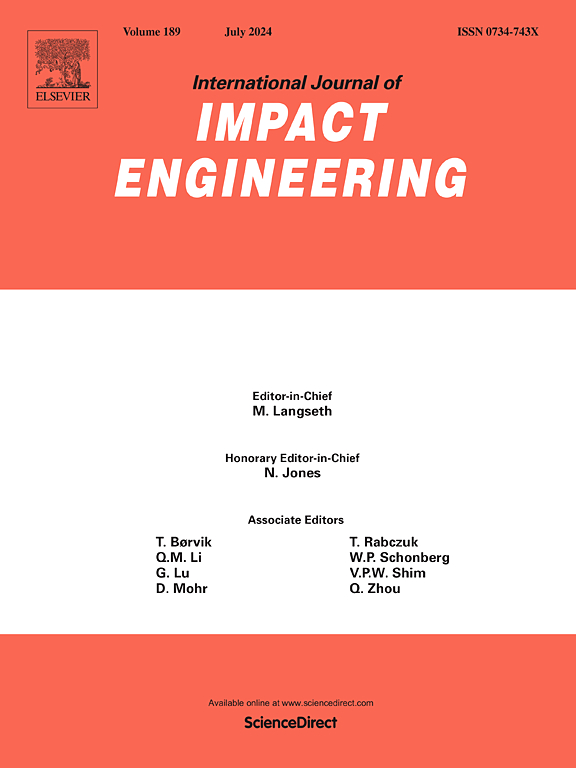基于桁架增强自适应有限元-点法的弹丸侵彻钢筋混凝土结构模型
IF 5.1
2区 工程技术
Q1 ENGINEERING, MECHANICAL
International Journal of Impact Engineering
Pub Date : 2025-06-12
DOI:10.1016/j.ijimpeng.2025.105437
引用次数: 0
摘要
传统的基于有限元法的弹丸侵彻钢筋混凝土结构模拟由于采用了单元侵蚀技术,往往存在质量损失和精度降低的问题。为了解决这些问题,本研究引入了一种新的桁架增强自适应有限元- MPM (TEAFEMPM)框架,该框架在统一的计算环境中无缝集成了实体有限元、桁架组件和材料点法(MPM)。混凝土使用三维实体单元建模,而钢筋则由一维桁架单元表示,通过基于速度和加速度的约束与混凝土耦合。当受到严重变形时,变形的实体元自适应地转化为MPM颗粒。剩余的实体元素、材料颗粒和桁架组件协同作用,以捕捉RC结构的完整动态响应。改良版卡拉戈齐安采用Case (K&;C)材料模型,结合增强的屈服标化规律和损伤演化规律,能更好地表征混凝土在外荷载作用下的应变软化行为。通过无侧限单轴压缩(UUC)和拉伸试验验证了自适应过渡和耦合策略。最后,对RC板弹丸穿孔的数值模拟结果与实验数据吻合良好,验证了TEAFEMPM框架的准确性和有效性。本文章由计算机程序翻译,如有差异,请以英文原文为准。
Modeling projectile penetration into RC structures using truss-enhanced adaptive FEM–MPM
Traditional FEM-based simulations of projectile penetration into reinforced concrete (RC) structures tend to suffer from mass loss and reduced accuracy due to the adoption of element erosion techniques. To address these issues, this study introduces a novel Truss-Enhanced Adaptive FEM–MPM (TEAFEMPM) framework, which seamlessly integrates solid finite elements, truss components, and the Material Point Method (MPM) within a unified computational environment. Concrete is modeled using three-dimensional solid elements, whereas steel reinforcement is represented by one-dimensional truss elements, coupled to the concrete through velocity- and acceleration-based constraints. When subjected to severe deformation, distorted solid elements are adaptively transformed into MPM particles. The remaining solid elements, material particles, and truss components interact synergistically to capture the full dynamic response of RC structures. A modified Karagozian & Case (K&C) material model is employed, incorporating enhanced yield scaling and damage evolution laws to better represent the strain-softening behavior of concrete under external loading. The adaptive transition and coupling strategy are validated through both unconfined uniaxial compression (UUC) and tensile tests. Finally, numerical simulations of projectile perforation in RC panels show excellent agreement with experimental data, confirming the accuracy and efficiency of the proposed TEAFEMPM framework.
求助全文
通过发布文献求助,成功后即可免费获取论文全文。
去求助
来源期刊

International Journal of Impact Engineering
工程技术-工程:机械
CiteScore
8.70
自引率
13.70%
发文量
241
审稿时长
52 days
期刊介绍:
The International Journal of Impact Engineering, established in 1983 publishes original research findings related to the response of structures, components and materials subjected to impact, blast and high-rate loading. Areas relevant to the journal encompass the following general topics and those associated with them:
-Behaviour and failure of structures and materials under impact and blast loading
-Systems for protection and absorption of impact and blast loading
-Terminal ballistics
-Dynamic behaviour and failure of materials including plasticity and fracture
-Stress waves
-Structural crashworthiness
-High-rate mechanical and forming processes
-Impact, blast and high-rate loading/measurement techniques and their applications
 求助内容:
求助内容: 应助结果提醒方式:
应助结果提醒方式:


